Evaluating America’s green energy options including astroelectricity (part 1)by Mike Snead
|
| Space solar power is the commonsense solution to America’s need for abundant green energy. Unfortunately, as of this writing, America finds itself on a terrestrial-focused green energy transition path that is likely to fail because of poor national energy policy choices are being made. |
We can now apply this truism to the industrial energy that feeds our technological culture. To continue to grow and expand—necessary to ensure that all of humanity achieves their inalienable right to freedom from want with prosperity—the environmentally acceptable sustainable (green) energy available per person must now be substantially increased to replace non-sustainable fossil carbon fuels (see “America’s moral obligation to develop astroelectricity”, The Space Review, February 14, 2022).
White’s full quotation is pertinent to this discussion of assessing America’s options of how to transition to green energy.
No culture can develop beyond the limits of its energy resources, and the cultures of primitive man would have been circumscribed by the boundary of human energy for ages without end had not some means been developed for augmenting energy resources for culture building by harnessing solar energy in a new way and in a new form. This was accomplished by the domestication of animals and by the cultivation of plants, especially the cereals. [Leslie A. White, The Evolution of Culture: The Development of Civilization to the Fall of Rome, McGraw-Hill Book Company, 1959. Emphasis added.]
Starting around 11,000 years ago, creative humans put humanity on the path to becoming a spacefaring technological civilization by intentionally harnessing solar energy. Some 500 generations later, humanity is on the cusp of completing this journey by expanding permanently into outer space to enable us to practicably tap the immense abundance of sunlight and space’s other natural resources to sustainably power our terrestrial civilization—just as Konstantin Tsiolkovsky, an early czarist Russian space exploration philosopher, predicted a century ago. Provided we now make wise choices on how to peacefully proceed, our children, grandchildren, and great grandchildren will be the three generations that complete this journey to permanent green energy security.
As America’s space solar power pioneers—including Peter Glaser, Gerard K. O’Neill, and John Mankins—have made clear, space solar power is the commonsense solution to America’s need for abundant green energy. Unfortunately, as of this writing, America finds itself on a terrestrial-focused green energy transition path that is likely to fail because of poor national energy policy choices are being made. The two primary reasons are that America now lacks a well-organized national energy security strategy to guide its transition to abundant green energy and the public lacks well-founded information with which to judge the rhetoric and actions of our political and private sector leaders.
The purpose of this series of articles is to quantitatively examine America’s green energy transition options to determine what is the most practicable solution—one “able to be done or put into practice successfully” from an engineering perspective—for America to end its use of non-sustainable fossil carbon fuels. As will be explained, when all terrestrial options have been examined in detail, astroelectricity generated from space solar power becomes the primary choice for America to practicably transition this century while remaining energy secure and prosperous. Once this transition path becomes apparent, America will need to join other nations seeking to become true human spacefaring nations striving to industrialize outer space to supply America and the world with abundant astroelectricity.
America’s past, current, and future use of fossil carbon fuels
The proper starting point for assessing America’s options to transition to green energy is to understand America’s past, current, and likely future use of fossil carbon fuels. Primarily, this is needed to appreciate the magnitude of the effort that America will require to complete its transition and why maintaining a robust domestic fossil carbon fuels industry is essential to a successful transition.
America’s past fossil carbon fuels use
Figure 1 charts the percentage breakdown of America’s use of industrial energy, by type of energy, since 1950. In 1977, when the US Department of Energy was established in the wake of the first oil supply crisis, fossil carbon fuels supplied 91 percent of America’s energy with a large percentage being imported oil. In 2020, despite nearly five decades of political rhetoric emphasizing the need for America to change to reliable sustainable energy sources, this percentage had only fallen to 79 percent. The rate of year-over-year decline has been less than 0.3 percent per year. Obviously, due to the lack of a well-engineered national security energy strategy guiding America’s transition to green energy, little has been accomplished in the last nearly half-century. Clearly, a rhetorically driven approach to ending the use of fossil carbon fuels has failed.
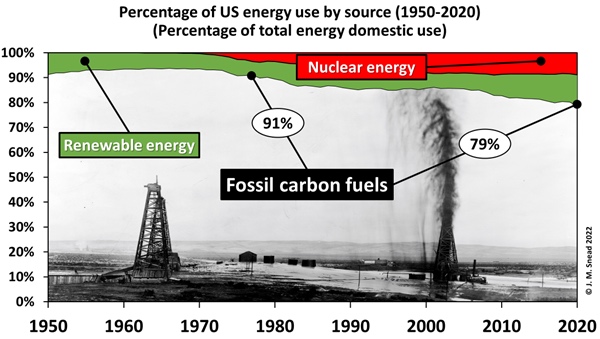 Figure 1 |
The dangers of national energy insecurity
Figure 2 charts the history of American domestic oil production and oil imports beginning in 1900. Substantial oil imports began in the 1950s to fully meet America’s growing post-World War II prosperity-driven energy demands. After 1970, when domestic (pre-fracking) oil production peaked, oil imports grew dramatically. The resulting oil insecurity created circumstances that led to the two oil supply crises in the 1970s, both resulting in severe recessions and high inflation. As a result, President Jimmy Carter in 1980 declared the Middle East’s oil resources a vital American national security interest resulting in decades of American-involved warfare that continues today.
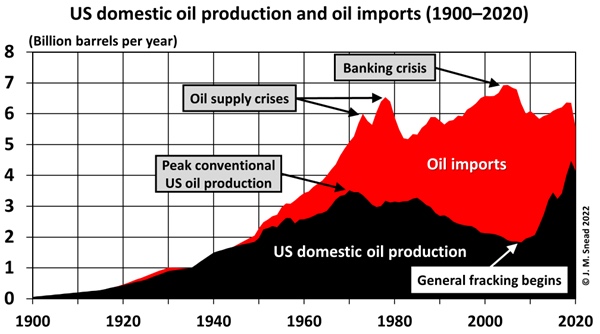 Figure 2 |
Up until 2008, America was increasingly oil insecure. A dramatic reversal came about with the broad commercialization of “fracking”—the combination of guided drilling and hydraulic fracturing—that opened deeply buried shale oil and natural gas deposits to affordable extraction. Just prior to the start of the COVID-19 pandemic in 2020, America temporarily achieved overall energy independence. Unfortunately, poor energy security policies undertaken since 2021 have increasingly weakened America’s oil and natural gas security by creating domestic production shortages, higher prices, and growing public anxiety about America’s energy security.
America’s persistent energy security fragility
Figure 3 shows the history of three key economic health indicators starting before the first oil supply crisis in 1973.
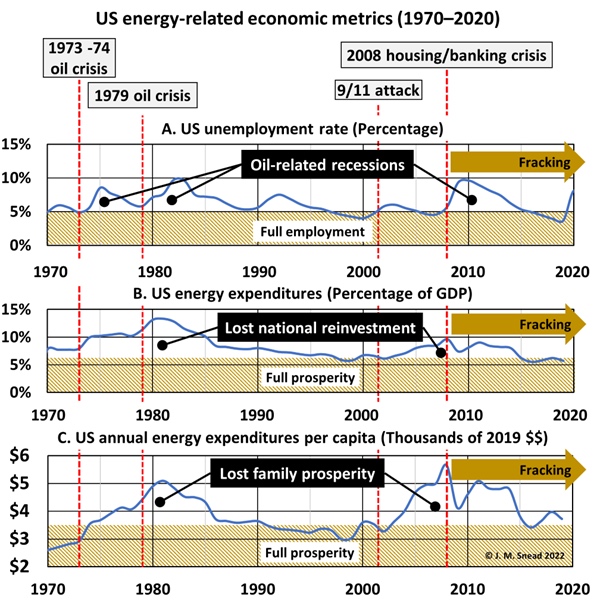 Figure 3 |
The top chart is the US unemployment rate. With full employment being when the unemployment rate falls below about 5%—generally indicating strong middle-class family prosperity—the history shows that throughout most of the last half-century, American families have suffered financially from the recessionary impact of higher energy costs causing higher unemployment. Recessions in the 1970s, 1980s, and late 2000s were all directly tied to increased American oil insecurity.
The middle chart shows national energy expenditures as a percentage of the gross domestic product (GDP). Any period with energy expenditures above around 5% of GDP shows that excessive funds were spent on energy instead of being directed to prosperity reinvestment in America through company formation, job creation, productivity improvement, and infrastructure repair and expansion.
| A successful national energy security strategy to guide America’s green energy transition must emphasize transparency and maintain middle-class American family prosperity throughout the transition. |
The bottom chart shows the average annual expenditure per person on energy, expressed in thousands of constant 2019 dollars. This is largely a hidden cost buried in the price of the goods and services used. Again, increasing oil insecurity drove families to spend more on energy and less on improving their prosperity and financial security. In particular, the 2008 financial crisis was, in part, triggered by the steadily rising cost of energy—a cost temporarily driven down by the subsequent growing use of fracking coincidentally beginning around 2008. Largely due to fracking, American family expenditures on energy were at a near historic low when the COVID-19 pandemic began in 2020.
Recently, the US Secretary of Transportation, Pete Buttigieg, expressed the point of view of many fervent environmentalists that economic “pain” at the pump was necessary to achieve lasting progress in ending the use of these fuels. The preceding chart of US energy use over the past half-century, when combined with the Figure 3 charts, clearly show that pain at the pump does not encourage a permanent end of the use of fossil carbon fuels. It only results in prolonged family financial hardship leading to reduced prosperity and lost national economic reinvestment opportunity. The reality is that engineers, not politicians, will bring about America’s transition to abundant green energy. The 1980s supercomputer in your pocket—simply now called a phone—is testimony to this reality. Greening America will require a substantial reengineering of America.
A successful national energy security strategy to guide America’s green energy transition must emphasize transparency and maintain middle-class American family prosperity throughout the transition. Importantly, the transition should be done in an orderly manner that is almost unnoticed by the energy end users and does not require reductions in the standard of living due to unaffordable increases in energy costs. Importantly, this strategy should reflect the fact that America’s need to now end the use of fossil carbon fuels is not the fault of Americans, but a circumstance brought about through the normal course of White’s “culture building.” We are simply at the moment in time—as happened earlier with the transition from wood to coal in the early 1840s—when an orderly engineering-led transition to green energy is required to sustain our industrial cultural growth with prosperity.
America’s future fossil carbon fuel needs during the transition to green energy
Reasonable people understand and accept that fossil carbon fuels are not sustainable. Hence, America’s need to transition away from these fuels is inevitable. For the purpose of this discussion, a target planning year to fully complete the transition is set for 2100. (Why 2100? This will become clearer later as the magnitude of the needed replacement green energy infrastructure is estimated.) Since we cannot simply just stop using fossil carbon fuels without collapsing our industrial culture, a reasonable starting question to ask is: From 2021 to 2100, how much more fossil carbon fuels will America still need?
Fossil carbon fuel consumption is reported using the energy unit called a “barrel of oil equivalent” or BOE. As we still use combustible fuels as our primary energy source, the advantage of using the BOE unit is that it has an understandable physical meaning. A BOE equates to the thermal energy available from the combustion of 42 gallons of crude oil. Further, all forms of the energy used, such as nuclear-generated electricity, can be expressed using this BOE unit by applying conversions.
In 2019, the US consumed 17 billion BOE of energy, of which 79% or about 14 billion BOE was fossil carbon fuels. On average, each American used—directly and indirectly—about 40 BOE of actual fossil carbon fuels in 2019.
As will be discussed in Part 3, through 2100, using US Census Bureau information, the US population is likely to grow by about 50% to around 500 million, primarily due to net international migration. To maintain America’s prosperity, for this assessment, the per person total energy need each year will be held constant at the 2019 level. However, beginning in 2021, the fossil carbon fuels portion will be assumed to decline to zero in 2100. Using these assumptions, an estimate of the total BOE of fossil carbon fuels needed through 2100 can be made. These results are shown in Figure 4.
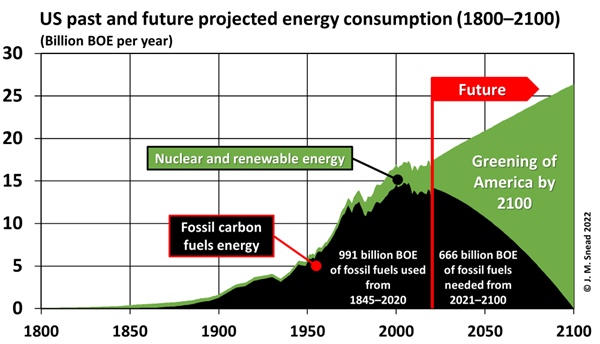 Figure 4 |
From 1845—when the general commercial use of coal began—through 2020, the United States consumed an estimated 991 billion BOE of fossil carbon fuels. However, of this total, only about 670 billion BOE, or about 68%, were domestically produced. The remainder—primarily oil as shown in Figure 2—was imported beginning in the 1950s.
From 2021 to 2100, America’s total energy need will climb from 17 billion BOE in 2019 to over 26 billion BOE by 2100. As shown in Figure 4, through 2100 the United States would still need around 666 billion BOE of fossil carbon fuels during a transition to full green energy by 2100. This amount of fossil carbon fuels through 2100 would equal the total amount domestically produced from 1845 to 2020. Surprisingly, even with an orderly transition to green energy, America is now only about halfway through its needed total use of fossil carbon fuels!
| However, an urgency to act does not mean that we should act irresponsibly. |
Common sense indicates that a robust American domestic fossil carbon fuel industry is required to enable America’s orderly transition to green energy while keeping America energy secure and prosperous. Thus, a key element of the needed national energy security strategy is to reestablish and maintain the ability of America’s fossil carbon fuels industry to fully meet domestic needs during the transition to green energy.
Managing the use of America’s remaining fossil carbon fuel resources
The US Geological Survey (USGS) periodically reports its estimates of the remaining domestic technically recoverable oil, gas, and coal resources. Essentially, this is the USGS’s best estimate of how much of these fuels could eventually be marketed without taking price into account. In total, the US has around 1,760 billion BOE of all fossil carbon fuels remaining, of which about half are oil and gas (see Table 1). This remaining American fossil carbon fuel abundance gives America—unlike Europe, for example—the freedom to chart its own path to green energy while ensuring continued middle-class prosperity.
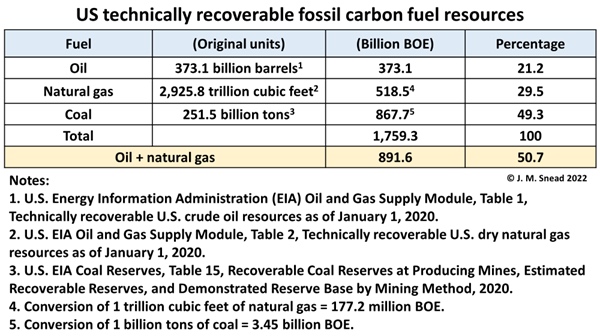 Table 1 |
In 2019, prior to the pandemic, total US oil and gas consumption accounted for 86% of the total fossil carbon fuels. Holding this percentage constant for this discussion, the US would need 573 billion BOE of oil and gas through 2100. From Table 1, we see that this would require the use of about two-thirds of America’s estimated remaining 892 billion BOE of oil and gas resources. Therefore, with a commonsense national energy security strategy, America can achieve and remain fossil carbon fuel energy independent throughout the transition to green energy while ensuring continued middle-class affordable energy costs through commonsense legislation and regulation.
Exporting American fossil carbon fuels to America’s allies
A clear side benefit of instituting an orderly green energy transition strategy is that America would then appear to have sufficient fossil carbon fuel resources to help our key national security partners also remain energy secure while they transition to green energy. However, exporting substantial amounts of American fossil fuels only makes sense once America has committed to its own orderly transition to green energy that will limit, as shown in Figure 4, how much of these fossil fuels America will need during its transition.
Addressing environmental considerations
Although the public’s environmental protection concerns regarding the combustion of fossil carbon fuels are not directly addressed in this article, these concerns remain an important energy security planning priority. While some debate whether our use of these fuels is causing measurable and significant negative impacts on the Earth’s biosphere, the rise in the atmospheric carbon dioxide level due to the combustion use of these fuels is scientifically established. Further, we now know that this level is unnaturally high compared to the last several hundred thousand years. Consequently, since a tested hypothesis has not been established that the rising carbon dioxide level is safe, undertaking an orderly transition to abundant green energy to end the use of fossil carbon fuels is the commonsense path to now follow. However, an urgency to act does not mean that we should act irresponsibly.
Modeling America’s future green energy infrastructure
General green energy transition model
A primary energy transition planning assumption is that an all-electric infrastructure is not practical. Carbon-based chemical fuels and feedstocks will still be needed for transportation, manufacturing, and as a convenient means to store energy for later times of increased need, such as severe weather and seasonal increases. With this assumption, Figure 5 illustrates a general green energy infrastructure that will supply both green electricity and green fuels—e.g., methane—to replace today’s energy infrastructure primarily operating with fossil carbon fuels.
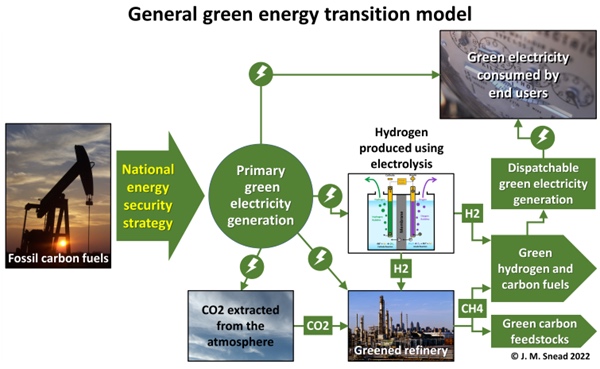 Figure 5 |
In this general model, green electricity becomes the primary source of energy being used directly and also being used to produce green hydrogen and green carbon fuels. These green fuels—such as diesel and jet fuels—will then be used by the end users and will be used by utilities to generate dispatchable green electricity to fully meet seasonal and weather-related demands. With this approach, the general nature, safety, and convenience of today’s industrial energy infrastructure will be maintained as America fully transitions to green energy. Properly engineered, the changes will be largely transparent to the public meaning that no “great reset” to a lower standard of living need happen for America to go green.
Primary sources of green electricity assessed
In applying this general model, the starting point is to define what primary sources of green electrical power might be sufficiently scalable to meet America’s total energy needs. As explained in Part 2, the United States will need primary green electricity sources capable of supplying the equivalent of thousands of two-gigawatt Hoover Dams operating continuously. For this reason, many renewable sources of green energy, such as hydroelectricity, geothermal electricity, wave- and tidal-generated electricity, biomass, and algae, are excluded from this top-level assessment because they cannot practicably be scaled up.
This leaves two sources of baseload primary electrical power and two sources of intermittent primary electrical power. As shown in Figure 6, the two baseload sources are nuclear fission power and space solar power-generated astroelectricity while the two intermittent sources are wind power and utility-scale ground solar power. America’s future green energy infrastructure will, absent a dramatic breakthrough in a better green energy technology, consist primarily of these options. To evaluate these options, the general transition model shown in Figure 5 has been expanded into two separate models, one for baseload sources and one for intermittent sources.
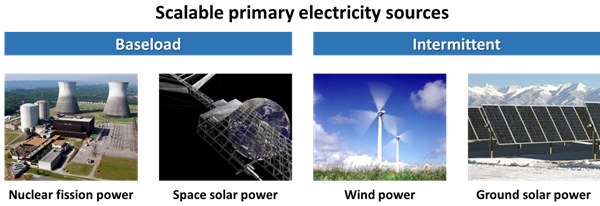 Figure 6 |
Baseload green energy model
Today, largely taken for granted, all electrical power needed is nearly always available to end users. Through careful power management, utilities balance supply with demand by drawing electrical power from a regional electricity grid as well as adjusting the total power generated by the utility’s own generation sources. The utility’s ability to nearly instantly balance supply with demand is what keeps the power grid stable while avoiding temporary brownouts or complete blackouts. For perspective, America has more than 3,000 electric utilities supplying 150 million customers.
| America’s industrial infrastructure needs a combination of both dispatched electricity and combustible fuels. |
To achieve this grid stability, a tiered approach to generating electricity is used. Large gigawatt-scale baseload powerplants supply around 50% or more of the total demand. The remaining portion is met by smaller power plants that can be gas turbine and diesel generators, hydroelectric or other renewable power sources, or stored power sources such as utility-scale batteries or pumped hydroelectric power. While the baseload plants run at full output—to operate at their best efficiency—the number of the smaller plants online constantly changes to meet the total demand. The stability of America’s power grid must be preserved with the transition to green energy. This means that we must be selective in what green energy sources to use to keep the grid stable and reliable.
A key factor in the stability of the power grid is its ability to automatically respond to changing demand. For example, every time a light switch is turned on, a demand “signal” propagates almost instantaneously back through the distribution system to the generation source. If this is a traditional spinning turbine generator, the extra electrical “load” causes the rotating turbine driving the generator to slow very slightly. The automatic control system senses this and adjusts the system settings accordingly to return the generator to the target output conditions. During the short period that it takes the control system to respond, the rotational inertia of the spinning generation systems enables the stored kinetic energy of the rotating machinery to be converted into electrical power preventing a brownout while the control system adds more input mechanical power. This rotational inertia—something, for example, that solar photovoltaic systems lack—is critical for maintaining grid stability. Hence, a well-engineered green energy infrastructure must provide sufficient power generation “inertia” to maintain grid stability.
Figure 7 portrays the adjusted baseload green model used in this assessment. Green primary baseload electricity is assumed to be used to supply utilities with dispatchable electricity—the same as, for example, coal-fueled baseload power plants do now—and to power the production of synthetic green fuels. Green hydrogen produced by electrolysis provides one green fuel. At “greened” refineries, this hydrogen can also be combined with carbon dioxide (CO2) extracted from the atmosphere to produce green carbon fuels, asphalt, lubricants, and industrial chemical feedstocks.
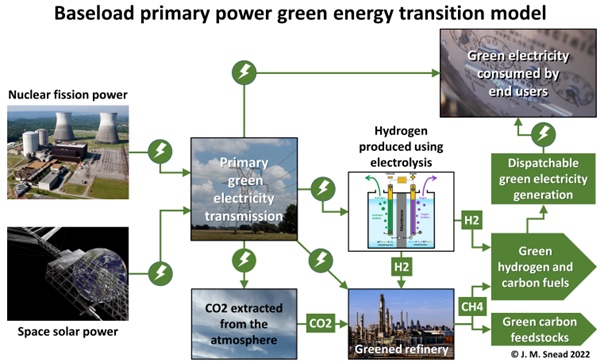 Figure 7 |
(Note: CO2 released from the combustion of these green carbon fuels will be recycled back into more green fuels so that no net additions of CO2 to the atmosphere will occur. As this capability is introduced, the existing fossil carbon fuels refinery industry will become “greened”, producing green fuels and related green industrial products. Over time, excess CO2 in the atmosphere can be extracted, turned into synthetic crude oil and methane, and returned to permanent geologic storage while also providing an emergency energy supply. The potential exists to return several trillion BOE of synthetic crude oil and methane into such storage as the atmosphere’s CO2 level is returned to normal. Of course, this can only begin once the world’s transition to green energy is completed.)
When using this model for this assessment, the green primary baseload power is assumed to provide two-thirds of the total electrical energy used each year. The balance is provided by high-efficiency, combined-cycle gas turbine generators fueled by green hydrogen or green methane. This enables utilities to continue to properly balance supply with demand while ensuring grid stability.
Intermittent green energy model
Figure 8 illustrates the adjusted intermittent green energy model used in this assessment. A green national energy infrastructure using an intermittent primary green power supply must, of course, continue to ensure electric grid stability and reliability while accommodating changing demand by season, day of the week, time of the day, and, of course, local weather conditions. Stable, highly reliable electrical power grids are vital to national energy security. Hence, the intermittent model’s difference from the baseload model is that no intermittent primary electrical power is assumed to be used by utilities to directly provide dispatched power to customers. Instead, all utility-dispatched power is generated using high-efficiency, combined-cycle gas turbine generators fueled by green hydrogen or green methane. As will be seen in Part 2, this has the effect of increasing the total primary intermittent power needed per person compared to using just baseload power.
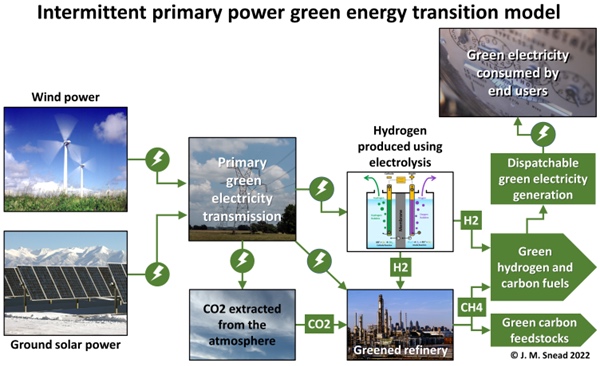 Figure 8 |
As shown in Figure 8, for this top-level intermittent power model, it is assumed that all primary intermittent green electrical power is sent to industrial hydrogen electrolysis and CO2 extraction plants and to greened refineries to produce green fuels. Extensive gigawatt-scale battery banks at these plants would be used to handle the variability of the intermittent primary electricity supply to enable the plants to operate efficiently using all available intermittent power. The synthetic green fuels produced are then distributed nationally using conventional means, such as pipelines, to supply utilities and end users. As with the baseload model, this approach makes the transition to intermittent green primary power largely transparent to the end users.
US green energy options evaluation matrix
As mentioned earlier, an all-electric green energy infrastructure is not practical. America’s industrial infrastructure needs a combination of both dispatched electricity and combustible fuels. Also as mentioned, four possible sources of primary electricity are assessed. When combined with two types of synthetic green fuels—hydrogen and methane—the eight cases to be evaluated are shown in Table 2. The quantitative results will provide valuable insight for charting America’s most practicable path to green energy.
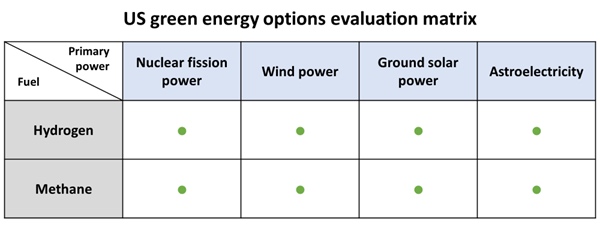 Table 2 |
(Note: This trade study includes both hydrogen and methane. The hydrogen case assumes that only hydrogen is produced and used as a fuel while the methane case assumes that only methane is used as a fuel even though hydrogen is produced to use in making green methane. The methane case is included because hydrogen is very difficult to use as a common fuel while natural gas—which is primarily methane—is widely and safely used. A future green energy infrastructure will likely use hydrogen in special circumstances, such as in greened refineries or some heavy industries, while methane and other green carbon fuels will generally be used to replace commonly used fossil fuels.)
Key points of Part 1
- America lacks but clearly needs a well-organized national energy security strategy—from an engineering perspective—to guide its orderly transition to green energy.
- With an orderly transition to green energy, America will still need a robust domestic fossil carbon fuels industry to keep America energy secure and prosperous during the transition.
- Quantitative trade studies are needed to guide selecting a practicable path for America to transition to green energy.
What’s in Part 2
Using the US green energy options evaluation matrix and the baseload and intermittent primary electrical power models, Part 2 begins the trade studies to define what would be needed to make America green. For perspective, comparable estimates for the European Union (EU), not including Britain, are also made. As a preview of these results, Table 3 summarizes the results for the US and EU for the year 2020 in terms of the equivalent number of Hoover Dams, operating continuously, that would have been needed to have already gone green.
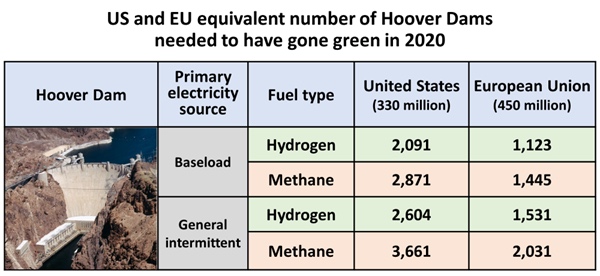 Table 3 |
Author’s note
The quantitative information presented in this article is provided for information purposes only and is not intended to be used for any other purposes. The author believes that the information provided is accurate, consistent with the top-level nature of these analyses and the sources of information used.
Note: we are using a new commenting system, which may require you to create a new account.
